This is a guest article written by Raymond Rendleman.
Ten days.
That’s how long it took before Portlander Vivek Jeevan was able to ride again and recover enough from the trauma of being intentionally hit by a road-raging driver last month.
Jeevan said he considers himself relatively fortunate. While he has heard from cyclists who get back behind their handlebars the day after a crash, he knows it’s common for a month or more to pass before trying again. And some never do. What keeps his dedication to road safety going, as education coordinator for nonprofit BikeLoud PDX and a certified League Cycling Instructor, are those who will never ride again.
“As part of my advocacy, we’ve supported victim families through court cases and seen a parent in front of a judge yell at a driver for killing their kid,” he shared with me in a recent interview. “I wanted to ask the perpetrator, ‘Was trying to save a few seconds on the road worth all of this?’”
Following his harrowing experience on June 2, he has had a grim realization about the frequency of incidents citywide where reckless drivers get away without consequences for intentionally targeting people riding bikes.
“Since that (BikePortland) article came out, people would approach me on rides — people I know and don’t know — and they would share their own story of getting hit and/or police not caring about them,” he said.
“I wanted to ask the perpetrator, ‘Was trying to save a few seconds on the road worth all of this?’”
Jeevan isn’t just relying on peoples’ stories. As perhaps America’s most prolific author of studies of behavioral causes of fatal bicycle and pedestrian collisions, he’s seen Portland Police reports reveal that a driver and a cyclist collide on average every three days during peak riding season, and every five days during the rainy months.
“Every three days — that’s so much suffering happens on our roads,” he said.
Jeevan’s brush with an angry driver and disappointing treatment by the responding police officer have given him a new perspective and appreciation for the topic he’s devoted years of advocacy to.
Jeevan doesn’t know exactly what it will take to change the culture on Portland streets, but he’s decided it’s time to get back to riding. Jeevan has resumed his regular schedule of teaching classes via his Portland Bicycle School service. He also led a Bike Safety Trivia ride on July 9th.
During the class, he reviewed the top causes of bicycle crashes, including the right hook, where a driver turning right through a bike lane hits someone proceeding straight. He cited an ODOT-funded Oregon State University study showing that 66% of drivers don’t look at the bike lane, even though drivers are legally required to yield.
“As cyclists it’s important to understand that two thirds of drivers will never check the bike lane before turning,” he said.
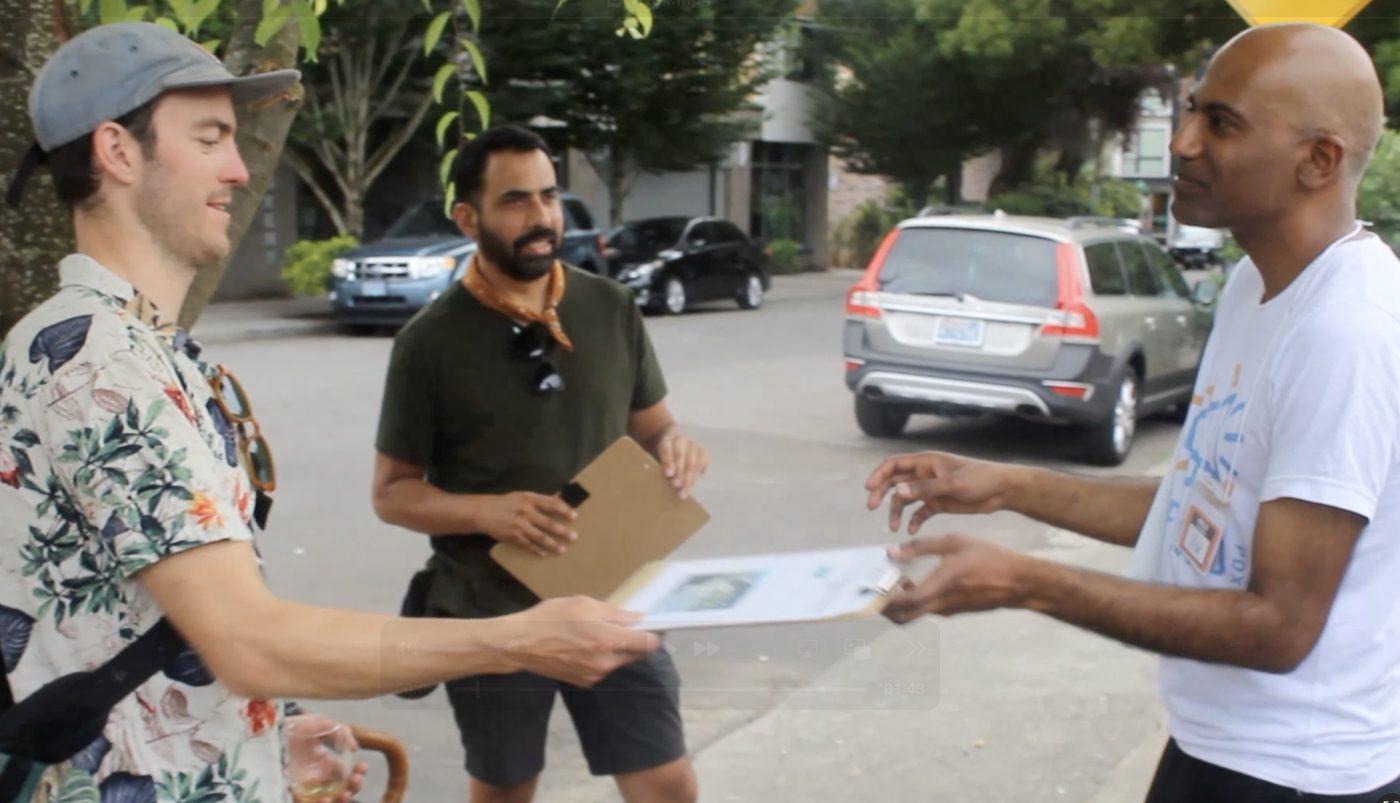
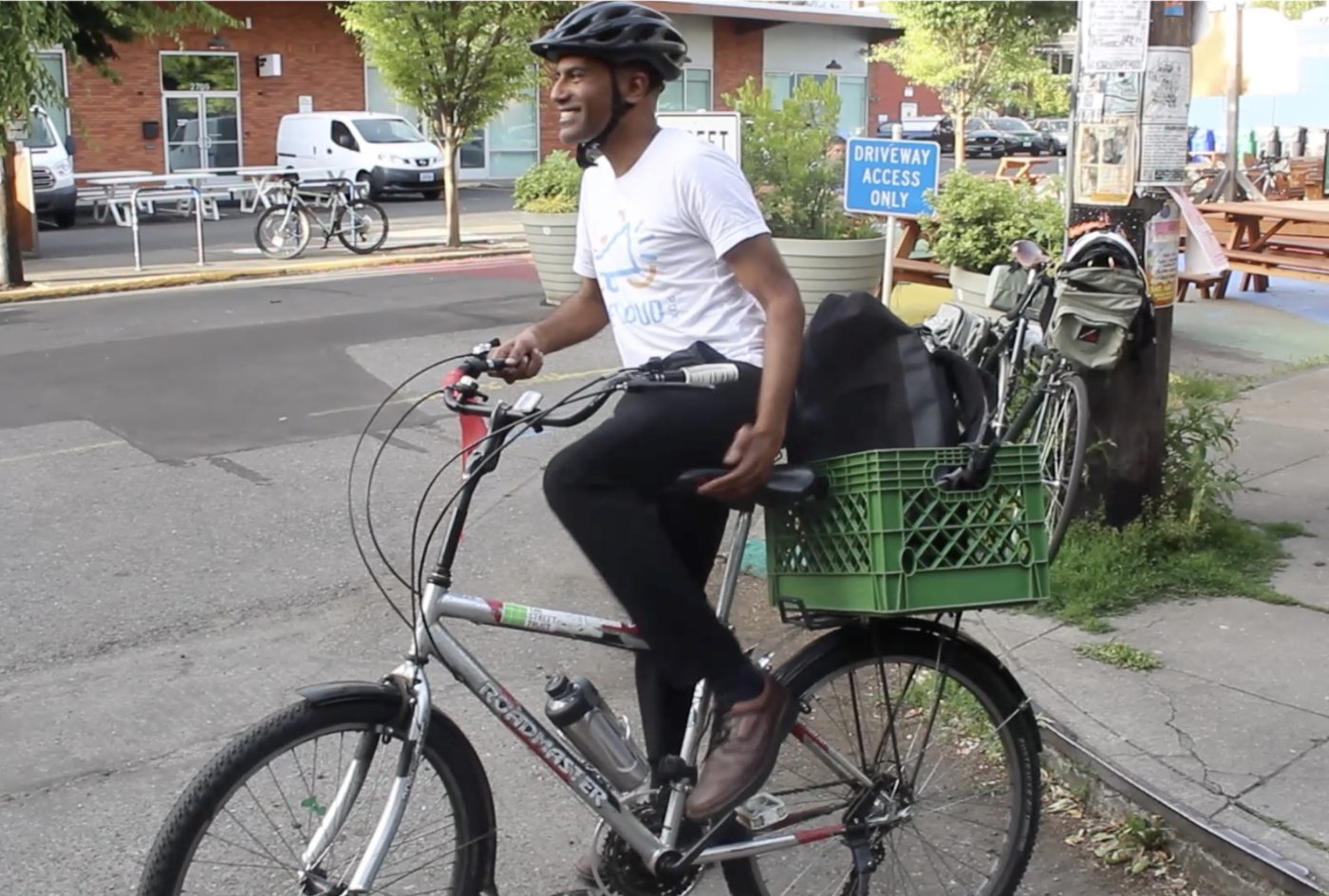
At this point in the class, a BikeLoud volunteer shared her own experience that drivers’ disabilities might be an additional factor on top of their general indifference to cyclists. “Lady Max,” who is legally blind and declined to provide her full name to BikePortland, said she gave up her driver’s license at the age of 48, when she learned to ride a bike for the first time. She said that the state could be doing more to prevent dangerous drivers such as herself from being behind 2,000-pound vehicles.
“I probably could have passed the driving exam because ODOT doesn’t give you a time limit to do the vision test,” she said.
Jeevan also covered the most common way for drivers to kill cyclists—unsafe passing—which was how he was intentionally hit in June. He reminded drivers at the class that it only delays you on average 20 seconds in the city to conduct a proper pass.
“Drivers can get grumpy when I say this, because it means that they have to slow down,” he said. “The situation will resolve itself quickly.”
Jeevan reminded everyone that slow and stopped traffic is normal and reasonable in every scenario and on every road. He said that “One road, many users” is a phrase for the variety of transportation forms allowed on Oregon roads — all of varying sizes and speeds.
And until Oregon repeals its mandatory bike-lane use law (something Jeevan once tried to make happen himself), he’ll continue to educate both bike and car users about how exceptions in the law allow cyclists to use the full traffic lane for their own safety.
“It might sound counterintuitive; but when you ride in middle of the lane, drivers tend to give you more space. And if they do try to pass too closely, riding in the middle allows you an escape route on the right,” he said.
Jeevan includes nuggets like that in his nine-hour bicycle class, which, similar to Drivers Ed, consists of parking lot drills, riding around town with an instructor, and a classroom discussion of laws and safety.
The number-one cause of cyclist deaths, Jeevan tells his students, is drivers splitting a lane to get around bicycle riders.
“Even though it’s legal to lane split in a car, it’s still deadly. As a traffic instructor, I stress universal best practices and hazard avoidance maneuvers, over local laws that vary,” he said. “This is trying to save seconds when there could be a lifetime of life lost to complete a dangerous maneuver.”
With evening coming and the class ending in the Ankeny Rainbow Road Plaza, it was time for everyone to bike home. Jeevan buckled his helmet, swiveled his head to check for traffic, put out his arm to signal, then headed west on Ankeny Street to downtown — right in the middle of the lane.
— Raymond Rendleman, rrendleman@gmail.com


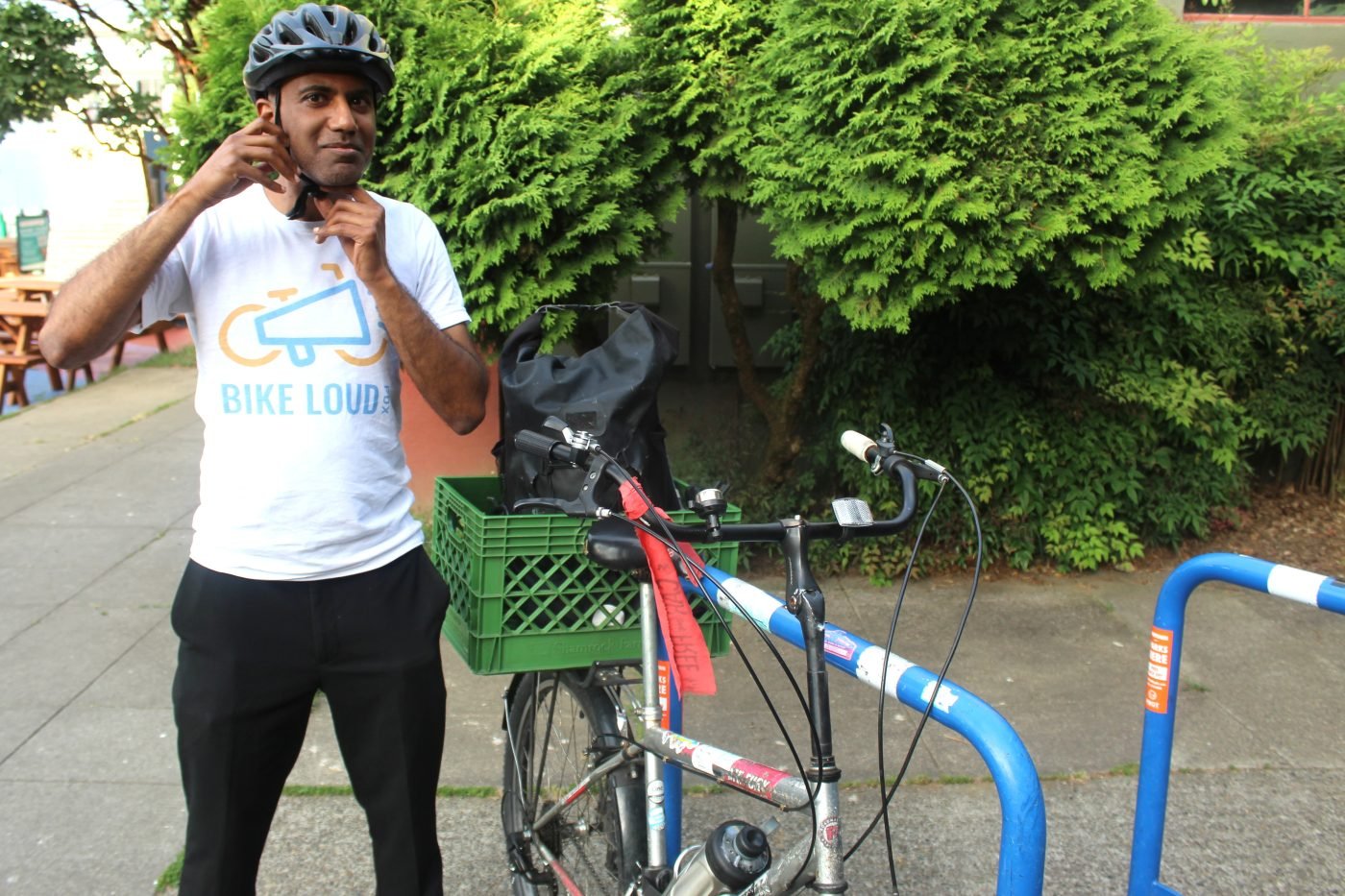
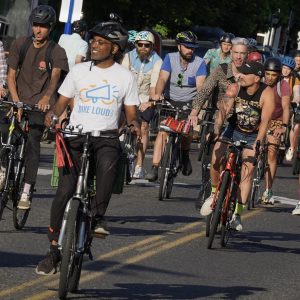


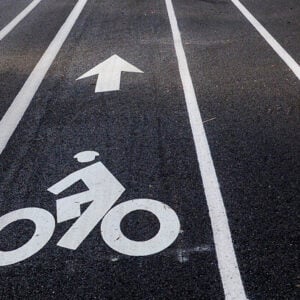
Thanks for reading.
BikePortland has served this community with independent community journalism since 2005. We rely on subscriptions from readers like you to survive. Your financial support is vital in keeping this valuable resource alive and well.
Please subscribe today to strengthen and expand our work.
Glad to see you back on the bike!
I mean, the story kinda says the opposite. And also tracks with most of the Pedalpalooza rides, where riders intentionally block automobile traffic for the purpose of provocation
You’re wrong about this (and likely other things)., When you ride the fog line, drivers will pass even if there’s oncoming traffic=cyclist gets squeezed and driver violates the 3 foot passing law.
Am I intentionally blocking automobile travel when I ride in the center of a travel lane? I mean maybe. Because yes, I want the person to have to think and evaluate if they can or even if they need to pass me in the 3 blocks before the lighted intersection. Is it provocation to take up as much space as I can in narrow chicanes so that I don’t get squeezed into a really dangerous position between a large vehicle, a drainage grate, and a concrete curb? Is that provocation or is it all people using the infrastructure for it’s purpose — providing space for us to get to school, work, and play.
The purpose of corking is provocation? What? I recommend you join a Kidical Mass ride, so you can get a feel for the safety corking provides to riders. Maybe if the riders are children your internal biases will see the benefit?
For the purpose of safe passage, not “provocation.”
Thanks for the write up! Glad he’s out rolling again.
On the other side of bike safety…actual BIKE safety, I hope that steer tube/stem situation was double if not triple checked for safety and stability
I hear you on that stem situation. FWIW Viv’s been rolling like that for a long time and I think he’s able to determine that it’s safe. He usually comes to Bike Happy Hour so I’ll ask him about it tomorrow.
I’m saddened to hear about the trauma that Vivek had to go through knowing what a cautious rider he is and all of his work teaching bike safety classes. More folks in the PDX bike community (myself included) have recently had close calls with careless and hostile drivers. Be careful out there especially in the heat when temperatures can flare.
Oh my goodness! I’m so sorry this happened to Viv! In just a few interactions via phone and email, he has played a significant role in my life as a cyclist –and as a car driver. I think about him EVERY time I am driving behind and looking to pass a cyclist. I remember that too often close passes are dangerous or deadly–his teaching–so I sit back and drive slowly until I have lots of room and vision, waiting until I can safely use the full oncoming traffic lane to safely pass.
I also check those bike lanes!
Vivek’s teaching (from just a few conversations) provided me with really useful teaching, legal awareness, and safety awareness, for both cycling and driving. I’m sure he’s an excellent teacher and he’s deeply compassionate.
When I had an uncomfortable encounter with a cop (who chastised me for “taking the lane” and said something like I was provoking drivers to use the other lane to pass me–um, yes, I thought that was a good thing…), Vivek talked to me personally and provided a lot of encouragement. I was really stressed out by the interaction with the cop, while riding with my 5 kids, and I fretted that maybe I was wrong and I was confused….Vivek provided support and encouragement.
Viv, I am so sorry for the dangerous, terrifying, actions of the driver, and even more sorry that you didn’t get support from the police.
I thank you for your teaching, advocacy, and encouragement. How can we support you? Do you have a GoFundMe for legal costs?
Another comment–JM, please delete or edit if I flub this one! : it wasn’t until my own interaction with a police officer that I understood why cyclists often describe their interactions with cops as being “biased” in favor of drivers and biased against cyclists.
I’m a white female from a wealthy background; wrongly but truly I recognize that I have enjoyed a situation of great privilege in my previous interactions with cops. (Bias was in my favor, and duh, it’s wrong, but yes I believe it happened), UNTIL I started cycling. Suddenly the interaction with a cop shifted so dramatically that it felt like being smacked in the face. Aha! That’s what bias against you feels like! Ouch. I had never ever had a cop talk to me “that way”–the threatening, look down on me, make me feel small, guilty and stupid, and at risk of being ticketed or arrested if I didn’t shut my mouth and get over to the side…
I hate that so many cyclists have this sort of experience. (And I also hate whenever anyone is treated unfairly, due to race or other factors, especially in police interactions, which can be really scary.)
It’s a stark memory for me, because I think it’s the only time in my life that I have ever experienced bias against me.
Viv, I commend your courage and your resolve. I hope you can continue to bike joyfully.